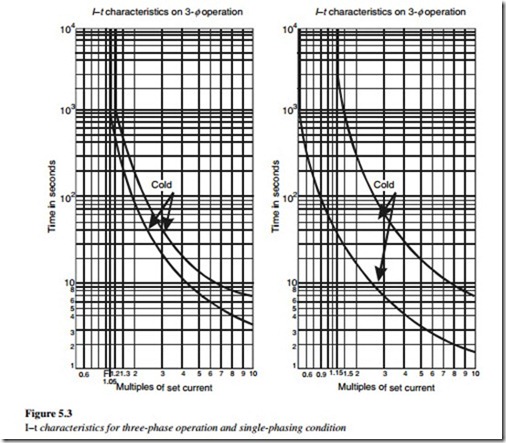Overloads and fault protection
Protection devices against electrical faults may be broadly divided into fuses or circuit breakers. In some applications, fuses are used with the circuit breakers to take over the interruption of higher short-circuit currents, particularly with the miniature or lower-rated MCCB.
Overload and fault protection in motor circuits
Often a motor is loaded beyond its rated capacity due to incorrect operating conditions. This leads to a motor overload, an increase in current flowing through the winding and an increase in the temperature of the winding. This results in a permanent damage to the motor winding and the cables.
In a motor circuit, the starter overload relays, protect the motor, and the associated cables against overload and the fuses in the circuit provide the required degree of short-circuit protection. A short-circuit protection is required to protect motor conductors, overload relays, and motors from the short-circuit condition. It is achieved by using the non-time delay fuse, instantaneous trip breaker, or the inverse time-breaker.
Usually, manufacturers give recommendations regarding the fuse ratings required to cope with the motor starting surges and indicate the minimum cable sizes required to achieve a short-circuit protection. In a well-designed combination, the starter itself interrupts all the overloads up to the stalled rotor condition. The fuses should only operate in the event of an electrical fault. The starter manufacturers indicate the maximum fuse rating, which may be used with a given starter to ensure satisfactory protection.
Bimetal relay with single-phasing protection
This is an overload protection provided externally to the motor. It is connected in series with the motor supply. A bimetallic strip operates once the temperature exceeds predetermined limits, causing the contacts to open.
After the relay has tripped and the contacts are open, the problem should be solved before pressing the reset button. The bimetal relays provide an accurate overload and an accelerated single-phasing protection for the three-phase motors. It incorporates a dual slider principle for accelerated tripping under the single-phasing protection.
The bimetal relay also provides protection against severe unbalanced voltages. The bimetal relays protect themselves against overloads of up to 10 times the maximum setting. Beyond this limit, they have to be protected from short-circuits. It is mandatory to use backup fuses. I–t characteristics for three-phase operations and single-phasing conditions are shown in Figure 5.3.
Phase failure relays
This protection interrupts power in all phases upon failure of any one phase. Normal overload relays or fuses may not protect the motor from damage due to single phasing. Phase-failure relay senses the negative-sequence voltage component of the supply and offers protection against phase failure, unbalanced phases, phase reversal, and under-and- over voltage faults.
Winding-protection relays
Winding-protection relays provide protection against overheating of the windings of motors, alternators, transformers, etc. Temperature is sensed with the help of a PTC thermistor embedded in the winding that gives a tripping signal when the temperature exceeds the response temperature of the thermistor.
In some cases, thermocouples or RTD (resistance temperature detectors) are fitted inside the winding to accurately indicate the temperature of the winding.
